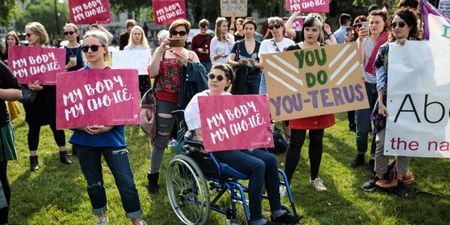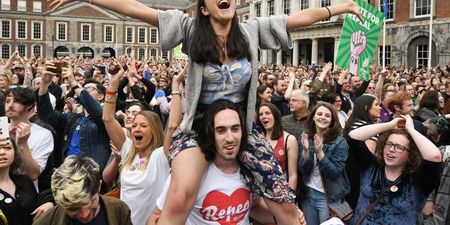You may not be aware, but Ireland has exported pregnant women to the UK for abortions for 85 years.
Although the UN classifies a lack of access to abortion as torture, Ireland’s restrictive laws on abortion remain. It is the only country in the democratic world to have a constitutional ban on abortion.
Only when a woman will die without the procedure is it allowed.
In Ireland the right to life of the unborn and the right to life of the woman are equal in the law. This is the stipulation of the Eighth Amendment introduced into the Irish constitution in 1983.
Increasingly the Eighth Amendment has featured in the international media as the women and men of Ireland have staged high profile protests against it. Most recently #TwoWomenTravel, a live account of two friends travelling from Ireland to the UK for an abortion, received widespread international press coverage.
Due the UK’s close relationship and links with Ireland, people in the UK are going to be hearing a lot about this issue over the forthcoming weeks and months, and it’s something that men in the UK should definitely take an interest in.
So where do you start? Probably by understanding the background and history that led to situation as it is now…
Ireland’s control of reproduction rights has a long and Catholic history.
The close relationship between church and state has meant Ireland has been comparatively reluctant to legalise the markings of progressive and civilised society; divorce was legalised in 1996, contraception for under-18s was made available in 1991, homosexuaility was decriminalised in 1993 and same-sex marriage became legal in 2015.
On average 12 women leave Ireland for an abortion every day, often to the UK.
This option however isn’t available to migrants with visa issues, minors in the care of the state, or any woman who can’t afford the estimated £1,250 it costs to travel.
For some, the Eighth Amendment protects and serves the unborn, for others it is a restriction which pits the rights of a woman against the right to life of the unborn.
But what precisely does the Amendment say?
“The State acknowledges the right to life of the unborn and, with due regard to the equal right to life of the mother, guarantees in its laws to respect, and, as far as practicable, by its laws to defend and vindicate that right.”
This is the phrasing exactly as it appears in the constitution and there can be no changes made to it without a referendum in the Republic of Ireland.
The campaign to introduce the amendment, which made it illegal for women to travel for abortion was extreme. In his book, The Transformation of Ireland, Diarmuid Ferriter quotes a pro-life poster that was circulated at the time, it proclaimed, ‘the abortion mills of England grind Irish babies into blood that cries out to heaven for vengeance’.
Abortion was already illegal in Ireland at the time but the amendment engraved the strength of a single pro-life lobby group into national policy and public consciousness.
The Eighth Amendment took its place in the Irish constitution at a time when the nation was heavily regulated by Catholicism, society was still fatally secretive about crisis pregnancy and the national tendency was to brush problems out of sight and across the Irish sea.
Women seek abortions for many reasons – their method of contraception failed, the economic, social, psychological struggles of a pregnancy are too much, they were raped, they have children and feel they couldn’t cope with another, they are older and fear their child might have a handicap, or, their foetus has a fatal abnormality that makes life outside the womb an impossibility.
The justifications for people seeking abortions are complex and consideration on a case by case basis is not an effective way of judging whether the procedure should be made available in Ireland.
Civil rights issue for a generation
Repealing the Eighth has become the civil rights issue for a generation who pushed through same-sex marriage and who have never had the opportunity to vote in a referendum to keep it or to erase it.
The Eighth Amendment is a campaign, an issue of contention and a matter of great confusion.
It has transformed from being the passionate cause of those who want to repeal it and those who want to celebrate it, into a contemporary national debate in Ireland.
The Eighth Amendment has drawn criticism from international groups, the UN and Amnesty International included, for its inhumanity. It raises issues that unsettle many to their core, the central of which is the right to life of the unborn versus the right to have control over your own body.
Abortion has been legal in the UK since 1931. The total ban on the procedure was lifted after a teenager was gang raped by a group of soldiers and she was granted permission to induce a miscarriage. Her case became the precedent for thousands of British women. Since that ruling 85 years ago, people have travelled from Ireland to the UK to terminate pregnancies.
The dependence on this option was revealed during the Emergency, when there was a travel ban for women between Ireland and England. During this period figures of both illegitimacy and infanticide rose.
The demand for abortion was as high then as it is now.
The deep shame in Ireland of having a baby outside of marriage and the possible imprisonment in a Magdalene laundry, the last of which closed in 1996, meant that an illegitimate pregnancy was a dangerous thing for a woman in much of the 20th century here.
Backstreet abortions in Ireland existed throughout the last century. Women risked their health and potential imprisonment to deal with the crisis of unwanted pregnancy. The most infamous practitioner of these illegal abortions was nurse Mamie Caddy, a midwife who in 1956 was sentenced to be hung for accidentally killing a woman during an illegal abortion and leaving her dead body on the street behind her Dublin flat.
In this era when a woman is able to publicy document her journey to England for an abortion and broadcast it to thousands and where women tell their abortion stories at open mics and in national newspapers it is difficult perhaps to understand how far we have come, socially if not politically.
Ann Lovett
In 1985, two years after the Eighth was introduced, Ann Lovett, a child of 15, gave birth alone underneath a statue of the virgin Mary in Granard, Co. Longford. Nobody knew she was pregnant. She lay on the cold ground for hours before anyone found her, her newborn son already dead. Ann Lovett died later the same day.
Her death shamed the nation as people asked; what society is ours, what morals do we live by, for a teenage girl to die rather than tell?
Ann Lovett’s death triggered an unleashing of women’s crisis pregnancy stories. From every county in Ireland women began to tell of the horror they had endured as citizens in a country that required them to be virgins or married wombs without limits.
This is the climate in which the Eighth Amendment ruled.
In 1984 a baby was found washed up on a beach in Cahirsiveen, Co.Kerry, dead from stab wounds and another baby was found in a plastic bag near Tralee. The Kerry babies tragedy threw female sexuality into public discussion. It forced people to examine the standards we hold our neighbours to and the destructive power of secrecy, shame and guilt around reproduction.
To kill a newborn baby is something so reprehensible that it is almost impossible to understand, but this is 2016.
Thirty years ago, to kill their baby was the only option some mothers could see.
The implications of the Eighth Amendment were unforeseen even by the government that allowed it through. After it became a part of the constitution, abortion was completely taboo and anyone giving information on the procedure was brought to court or shut down. The right to travel for an abortion was also made illegal.
Several high-profile cases have resulted in clauses being added onto the Eighth Amendment.
The X case
In 1992, a 14 year old girl who had been raped by her neighbour, was prevented from leaving the country to have an abortion. The X case caused uproar as Irish people found the idea of a 14-year-old being imprisoned in the country greatly disturbing. The X case reversed the legal practice of forbidding women to travel for abortions and an average of 5000 women now go overseas every year.
Not every case has resulted in political change but all have drawn anger from the Irish public and passive platitudes from politicians. Miss Y, a suicidal teenage asylum seeker and rape victim was refused an abortion and forced to carry her pregnancy to viability and deliver by C-section.
In 2014 a young woman who was brain-dead was kept alive against her family’s wishes so her body could act as an incubator for her 16 week old foetus. These cases and others have strengthened the pro-choice movement in Ireland.
After the death of Savita Halappanavar, who was refused an abortion that could have saved her life, the government passed The General Scheme of the Protection of Life During Pregnancy Bill 2013.
This Bill reaffirms abortion as an illegal practice in Ireland and retains the punishment of a maximum of 14 years in imprisonment for procuring one in Ireland.
The bill sets out the specific incidents where if the mother’s life is at risk, a termination may legally be carried out.
The conditions to this are;
- The risk of loss of life of the mother from physical illness – this risk must be agreed upon by two medical practitioners.
- The risk of loss of life from suicide – this must be approved by two psychiatrists, one obstetrician/gynaecologist and a GP.
There is a general consensus on both sides of the argument that the Eighth Amendment has been pushed as far as it can be in its current format. No more clauses can be added and an updated constitution is being called for.
Citizens assembly
The Irish government has responded by organising a citizens assembly commencing in October. The assembly will consist of 99 people, a kind of mini-republic, who will gather under the direction of Supreme Court Judge Mary Laffoy. The ‘citizens’ will be selected by the polling company Red C who will be looking to create an assembly that is representative of the Irish population in age, gender, economic background and religion.
The assembly will be required to discuss and report to the Dáil its views on the future of the Eighth Amendment. Its recommendation will then be considered by an legislative committee, before a decision on any referendum is made by Dáil Éireann.
This strategy has been called meek by both sides of the abortion debate who are accusing the government of refusing to take a definitive stance.
A citizens assembly, with all of its limitations, is one way for the government to gauge the mood of country and judge whether a referendum on the Eighth would pass.
The same-sex marriage referendum was also debated in a similar assembly, before a recommendation was made to the government that resulted in a referendum. It is a process that can effect change.
The debate around abortion is particularly difficult because unlike the same-sex marriage referendum, this shakes people, forces them to confront ethical issues and ask the existential questions of what is life and where does it begin?
The anti-abortion movement tells people that every abortion kills an unborn child. The pro-choice movement is asking people to release the control of women’s bodies from the hands of politicians into their own.
The opposing sides of this argument, however, are not fighting against each other.
They are fighting with a government who is refusing to take leadership on an issue that demands representation.
Hard questions
The exportation of abortion is a reality and it is a government endorsed solution to a problem which they have never known how to face.
This debate is increasingly ugly as both sides refuse to listen to the other or to deal with the questions raised by those who are struggling with the morality and practicalities of abortion.
And people are struggling, they are asking the hard questions:
- Should abortion be available on demand?
- Should Fatal Foetal Abnormalities come under the same category?
- Should the government pay for abortions as part of the public health service?
- How many weeks into a pregnancy would an abortion be legal?
- Would there be after-care for women?
- Would fathers be consulted?
- Would fathers even be notified?
The position of men in this debate is an uncertain one. Where can they stand on the issue, and how can their voices be heard? It is the essential nature of our biology that a woman holds a pregnancy in her body. The role of men in reproduction is increasingly being diminished and this can be an isolating position. It can be difficult then for a man to accept that his child could be terminated without his knowledge or consent. Equally, it is difficult for men to see women in pain as they endure a pregnancy they do not want.
Men in the UK
Men are entitled to an opinion on this and they should be listened to and heard, not only from the sidelines but from the centre court. Abortion is not a feminist issue or a woman’s issue, it is a human issue that affects both genders.
The UK interest in the repercussions of the Eighth Amendment should extend beyond incidental. This is an issue affecting thousands of men and women and its implications have never restricted themselves to geographical boundaries.
The fact that women have to travel to the UK in order to undergo an abortion means this is an issue that, at the very least, people in the UK should take an interest in following.
That so many people in the UK have relatives and family in Ireland means we’re likely to know people who are directly affected by the Eighth Ammendment, and people who would be affected if it is eventually repealed.
A version of this article was first published on JOE.ie and has been partially rewritten and edited for a UK audience.



















































